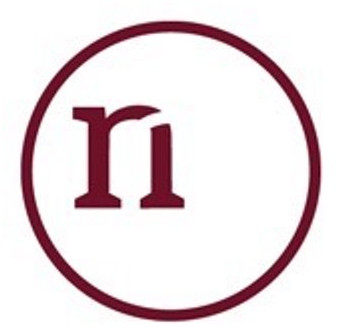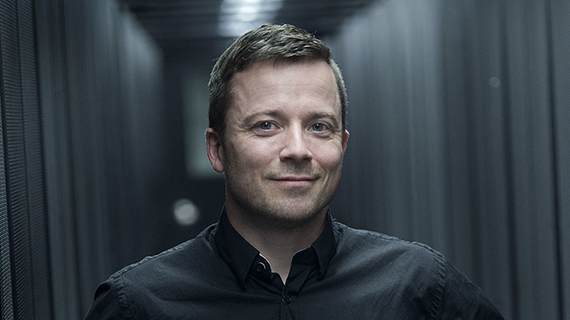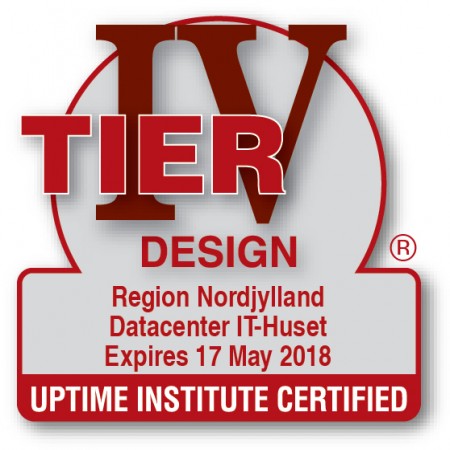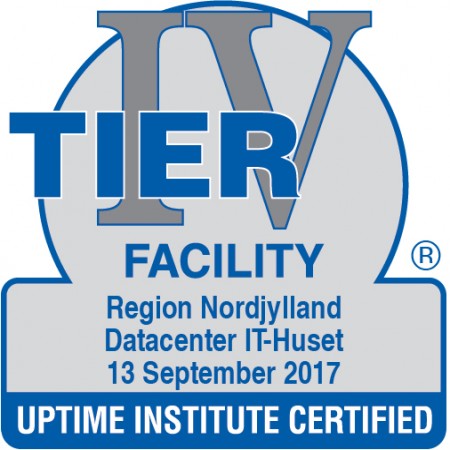História do cliente: Hospital Regional de Nordjylland, Sistema Regional de Saúde

Klaus Larsen
CIO, Região de Nordjylland

Crédito para fotos: Buzina Lars, Baghuset
O desafio
Atualizar o data center existente criou riscos que poderiam afetar potencialmente a segurança e o bem-estar dos quase 600.000 residentes da região. Na Dinamarca, o governo regional tem três responsabilidades principais: assistência à saúde, desenvolvimento regional e serviços sociais, e depende de apenas dois data centers para fornecer o suporte de TI necessário. Os médicos, enfermeiros e administradores que trabalham no hospital confiam na TI para fornecer suporte clínico e administrativo. Os cidadãos da região também dependem desses data centers, não apenas para apoio clínico, mas também porque a Região Nordjylland é responsável por vários sistemas nacionais, incluindo 911 chamadas de ambulância (emergência). No total, o data center regional da Dinamarca de Nordjylland abriga mais de 500 sistemas, incluindo 911 serviços de ambulância, registros de saúde de pacientes, sistemas de suporte a decisões e outros sistemas críticos que apoiam mais de 15.000 funcionários.
A solução
Um esforço colaborativo para atender aos requisitos de Tier IV
Para atingir suas metas de certificação Tier IV, a Região Nordjylland começou consultando e aplicando o Tier Standard do Uptime Institute: Tier Standard Documento de padrões de topologia. Isso forneceu uma linha de base para a equipe identificar e entender os requisitos para obter a certificação Tier IV.
Em segundo lugar, a Região Nordjylland aproveitou a experiência de seu pessoal existente. Os funcionários do departamento de TI regional da Nordjylland e do departamento técnico do Hospital Universitário de Aalborg colaboraram no planejamento, projeto e desenvolvimento do data center, para que o data center fosse totalmente projetado pelos próprios funcionários da Nordjylland regional, com experiência em operação e projeto de instalações hospitalares. Orientada por sua extensa experiência em operações de missão crítica, a equipe usou soluções simples, mas eficazes, projetadas para operabilidade e manutenção.
Steffen Jacobsen, diretor técnico do hospital, esteve muito envolvido no processo de projeto e construção. Jacobsen passou muitos anos projetando hospitais e ofereceu sua experiência ao departamento de TI.
Em busca da certificação Tier IV, Jacobsen e Sørensen fizeram o curso Accredited Tier Designer (ATD) do Uptime Institute. Durante o curso de treinamento de três dias, Jacobsen observou que hospitais e data centers têm muitas semelhanças: "Operar um data center não é tão diferente de administrar um hospital. Os hospitais devem ter água limpa, ar limpo, ar condicionado, equipamentos médicos e scanners confiáveis para o cuidado dos pacientes, mas também têm geradores, nobreaks e sistemas de refrigeração."
A combinação da experiência em gestão de data centers da Sørensen e da experiência em tecnologia da Jacobsen em operações técnicas hospitalares valeu a pena, e a Sørensen credita à Jacobsen a identificação de 30 erros no projeto inicial.
Jacobsen também tem obtido conhecimento do curso de ATD para o hospital. Sørensen observou: “Jacobsen é conhecido por passar pelo hospital com o livro ATD do Uptime Institute em suas mãos”. Como resultado, a Região Nordjylland está tentando usar o Tier Standard em “pacientes próximos a suprimentos”, como oxigênio e água limpa e estéril”. Dessa forma, toda a instalação está adaptando as lições aprendidas com seus data centers à operação e ao projeto de sua instalação de saúde e entrega.
Os requisitos para construir para o Tier IV diziam respeito aos funcionários da Região de Nordjylland muito mais do que o desafio de servir continuamente as cargas vivas existentes. Apesar do fato de que toda a infraestrutura do data center foi substituída ou atualizada durante a construção, exceto os servidores e os racks, a transição da carga em tempo real foi relativamente fácil porque eles haviam planejado meticulosamente para a mudança. De acordo com Michael Lundsgaard Sørensen, gerente de data center da região de Nordjylland e chefe de operações de TI, "Já tínhamos um lado A e um lado B, e tínhamos uma solução 2N. Basicamente, pegamos emprestado um gerador externo e um sistema de resfriamento externo, por isso construímos o novo lado A e acabamos de fazer o switch e ligar o novo."
O mantra da equipe de design: “Mantenha simples”
“Descobrimos que a coisa mais difícil sobre projetar um data center Tier IV é fazer algo muito complicado e simples. O mantra da equipe de projeto foi "Mantenha Simples", e é por isso que não temos controles de computador, como um sistema de gestão predial (BMS) e controladores lógicos programáveis (PLC)." Inicialmente, a equipe de design teve dificuldades para alcançar essa meta, pois os primeiros designs tinham vários pontos fracos que precisavam ser corrigidos.
O uso de controles industriais por Nordjylland, em vez de BMS e PLCs, é um exemplo da abordagem simples, mas eficaz. Maddison observou que o esquema de controle do hospital depende principalmente de sinais e controles elétricos, em vez de sistemas computadorizados, para alcançar a resposta autônoma a incidentes necessários para a Certificação Tier IV.
O resultado
“Nas mais de trinta avaliações de Tier Certification of Constructed Facility do Uptime Institute que concluí, esta foi a melhor preparada e mais bem executada”, disse Eric Maddison, consultor do Uptime Institute. “É uma conquista incrível atualizar um data center existente para os padrões exigentes de um data center com certificação Tier IV do Uptime Institute, e a equipe da região de Nordjylland fez um trabalho exemplar.”

Michael Lundsgaard Sørensen
Gerente de data center e chefe de operações de TI
Região de Nordjylland

Phil Collerton
Diretor de receitas
Uptime Institute
Fotos do Centro de Dados do Hospital Universitário Region Nordjylland Aalborg






Destaque da inovação: Reduzindo custos de Tier IV usando sistemas mecânicos para automatizar respostas a interrupções
Eric Maddison, consultor do Uptime Institute, comentou: “A Region Nordjylland tem tido sucesso no desenvolvimento de um conceito de resposta e controle autônomos que é mais barato do que um sistema de gestão de CTS tradicional”.
Os Subsistemas de Controles e Registro (CTS) do hospital dependem da resposta elétrica e mecânica para:
- Detectar alarmes críticos e não críticos
- Alertar a central de alarme e o pessoal-chave
- Registrar e registrar alarmes na instalação Tier IV
- Registrar e registrar dados operacionais na instalação Tier IV
- Tensão e ampères do motor-gerador.
- Tensão de saída do nobreak e ampères.
- Status de resfriamento livre.
- Erro de resfriamento livre.
- Temperaturas externas e ambientais (corredor quente e corredor frio)
- Temperaturas da água de resfriamento livre e do resfriador (entrada e saída)
- Temperaturas da água de resfriamento na fileira (entrada e saída)
- Temperaturas na sala do gerador A, sala do nobreak A e sala do resfriador A
- Pressões de água e salmoura em resfriadores, resfriadores em fileira e circuitos de refrigeração secos e livres
“Por exemplo”, disse Sørensen, “As cargas no data center são monitoradas por um alarme de corrente. Se a soma das correntes em uma das fases da alimentação A e da alimentação B exceder o máximo de qualquer uma das fontes, um alarme sonoro soará e um alarme crítico será gerado nos sistemas de alarme A e B. O alarme continuará até que a carga esteja dentro do máximo permitido.”
“A região de Nordjylland mostrou previsão ao projetar e construir o primeiro data center com Tier IV Certified do Uptime Institute na região. O foco na obtenção da certificação Tier IV para o projeto e a instalação construída significa que o data center está pronto e é capaz de apoiar o serviço de saúde para as gerações futuras”, disse Phil Collerton, diretor de receita do Uptime Institute.
Igualmente importante e impressionante, a região de Nordjylland concluiu sua atualização sem afetar a carga energizada. Os enfermeiros clínicos, médicos e pacientes nunca sabiam que todos os cabos, tubos, bombas, refrigeração e sistemas elétricos que atendem os data centers haviam sido substituídos. Na verdade, a Região Nordjylland substituiu tudo em seu data center, exceto os servidores e os racks.
Saiba mais sobre a região de Nordjylland
O novo data center tem uma capacidade de TI de 225 quilowatts. O acesso à sala de computadores de 211 m2 é estritamente limitado, pois está localizada em um porão de 1225 metros quadrados (m2) de um edifício governamental de 35 anos e quatro andares. O porão em si fica a 8 metros abaixo do solo. O edifício inclui paredes de concreto de 43 centímetros de espessura, portas automáticas reforçadas com aço construídas para suportar possíveis ameaças enfrentadas pela nação naquele momento. A localização no norte da Dinamarca também significa que o data center pode fazer uso extensivo de resfriamento livre, o que reduz o uso de energia da instalação.
Data centers Region Nordjylland com certificação


